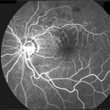Monday, 3 June 2013
Seeing What’s in Your Eye

The structure of your eye is a lot like that of a traditional film camera. The lens of your eye is like the camera’s lens. Your iris is like the diaphragm, and your retina, at the very back of the eye, acts like the light-sensitive film.
However, there is a hole in your retina that lets the axons of its ganglion cells (a kind of neuron) exit the eye while letting blood vessels enter to irrigate all of the retina’s neurons. This hole creates a true “blind spot” in your field of vision. You don’t notice this blind spot in your daily life. But, as explained in the first video to which I provide a link below, if you close one eye and use the other to look at a target a certain distance away, you’ll see this part of your field of vision literally disappear.
You also don’t notice the many blood vessels that lie between your retina and the outside world. The reason is a phenomenon called neuronal adaptation, which is also explained very well in the same video. This video shows a simple trick that you can use to “defeat” this adaptation and see the blood vessels in your own eye. If you’re like me, you may get somewhat emotional the first time you see these helpful friends who have been hiding right before your very eyes ever since you were born.
The second video to which I provide a link below, by the same author, is even more amazing, because in this one, he shows a trick that lets you actually see the white blood cells in the blood vessels of your eyes. These cells are so tiny that they are invisible to the naked eye, but if you look up at a clear blue sky, you’ll have a good chance of detecting them, in the form of tiny points of light. The explanation involves the absorption of the wave length of blue light by your eye’s red blood cells. Once again the video’s author provides a very clear explanation by drawing on a white board, this time in a speeded-up fashion reminiscent of the RSA Animate series of knowledge-visualization videos.
![]() Why we have blind spots – and how to see the blood vessels inside your own eye!
Why we have blind spots – and how to see the blood vessels inside your own eye!
![]() How to see white blood cells in your eye – the Blue Field Entoptic Phenomenon
How to see white blood cells in your eye – the Blue Field Entoptic Phenomenon
The Senses | Comments Closed








